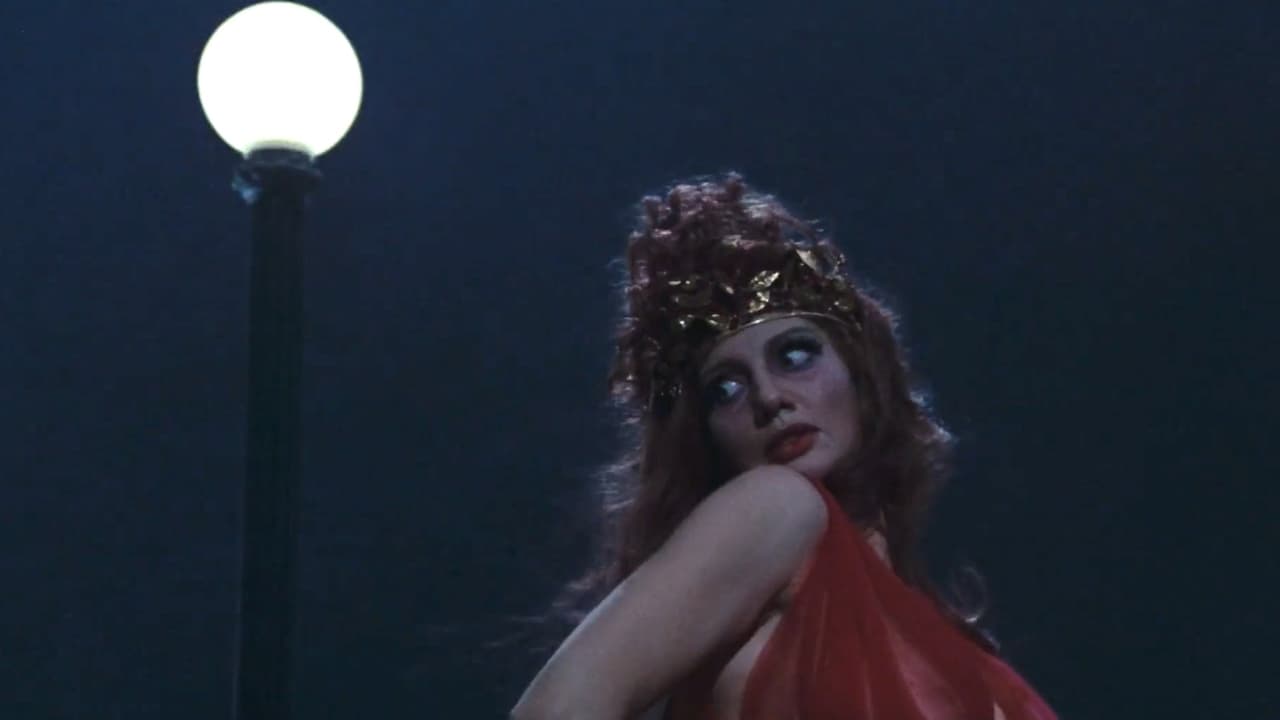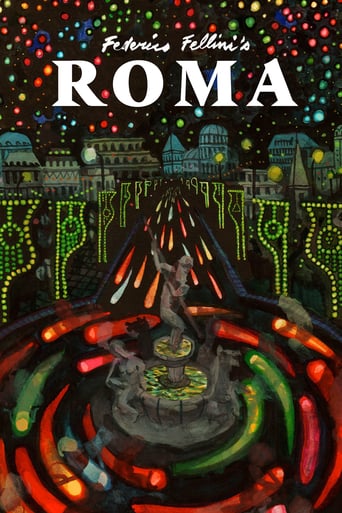

Fellini's ROMA imposingly alternates between two paralleled narratives in Rome, his salad days during the WWII and the beginning of 1970s, when he is an eminent filmmaker making a new film about the city, erratically charts its local customs and folk culture to pay homage to an ancient and great city. Structurally, the film doesn't stick to a linear one, instead it disguises with a pseudo-documentary style, in fact, most of the scenes were re-constructed in Cinecittà, however, Fellini stuns audience again with his majestic undertaking which significantly blurs the line between fiction and non-fiction.The film is not just an ode to the city, more prominently, it is the clashes between past and present that reverberate strongly today. His young self (played by Falcon), a doe-eyed townie arrives in Rome for college, enjoys a boisterous dinner in the street trattoria with the entire neighbourhood, watches a shoddy variety show with crude spectators which would be interrupted by an air raid, flirts with the brothel for the first time; when time leaps forward to the 1970s, the flower-child generation is consuming with alienation and torpidity, a poetic episode of the underground metro construction team encounters an undiscovered catacomb, where fresh air breaches into the isolated space and ruins all its frescoes in a jiffy. A superlative conceit encapsulates the dilemma between modern civilisation and ancient heritage.There is no absence of Fellini-esque extravaganza, the brothels during wartime are quintessentially embellished with crazed peculiarity and vulgarity for its zeitgeist and national spirit, where sex can be simply traded as commodity without any emotional investment. The most striking one, is the flamboyant fashion-show of church accouterments organised by Princess Domitilla (De Doses) for Cardinal Ottaviani (Giovannoli), consummated in an overblown resurrection of the deceased Pope, it is sacrilege in its most diverting form, only Fellini can shape it with such grand appeal and laugh about it.Two notable celebrity cameos, Gore Vidal, expresses his love of the city from an expatriate slant, and more poignant one is from Anna Magnani, her final screen presence - Ciao, buonanotte! - a sounding farewell for this fiery cinema icon. The epilogue, riding with a band of motorists, visiting landmarks in the night, Fellini's ROMA breezily captures this city's breath of life, sentimental to its distinguished history, meanwhile vivacious even farcical in celebrating its ever-progressing motions, a charming knockout!
... View More"Roma" is a feature with neither plot nor timeline and composed by an edition of disconnected footages of Rome, the Eternal City. Fellini makes a homage to Rome and depicts and entwines moments of the ancient and the modern Rome, such as during the fascist period of Mussolini; building the subway; in a traffic jam; a fashion show for the Church members; brothels with clients and prostitutes on display; repression; ordinary people on the streets and restaurants. For fans of Fellini and Rome, this movie may be a must-see; otherwise, it may be boring and too long. My vote is five.Title (Brazil): "Roma de Fellini" ("Fellini's Roma")
... View MoreIt's hard for me to render an objective verdict on Fellini Roma because, while being a rather unbalanced film--containing some trite stuff along with cinematographic gold--it also includes three episodes that fascinate me. The first one directly involves something I love, that's the journey of the film crew along the tunnel of the subway in construction. There is something surreal about that segment, something that gives it an out-of-this-world quality, while still belonging to our day to day, trivial reality. In my I Vitelloni review I said that Fellini had the capacity of making classics out of the most ordinary situations and this scene proves it. Because there's nothing in such episode that doesn't belong to our everyday reality, yet the feeling is that of a magical journey, something out of a fable. For ex., when the engineer orders to activate the cutter, what comes next doesn't look like a simple mechanical procedure, the drilling of a rock, but as it he had awakened instead a prehistoric monster, a dragon who was sleeping in the depths of the Earth and who starts suddenly breathing, slowly raising on its hinged legs over the men, thrusting its Alien-like jaws towards them. Here's is where Fellini's cinematographic genius appears at its best, as scenes like that one we may have seen many times in the news in TV, in civil engineering films, yet here the thing becomes surreal, straddles the realm of the fantastic. And all those effects, the eerie atmosphere, have been achieved simply with camera angles, lightning, the hovering dust, and the fact that all we hear is the life-like roar of the cutter. But he goes even further, he flirts also with the esoteric: even before the crew gets into the 2000-year Roman house, we viewers see what it's inside. Amazingly enough, one of the frescoes contains the uncannily accurate portrait of one of the crew members, who starts at that very moment feeling sick. Coincidence? Point for reincarnation? Lots to ponder there.The second episode I loved is that of the chaos in the highway, specially the night scenes. Compare the incredible vivacity of it, the joyous exuberance, the pulsating life of the city in the midst of the mass of intermingled cars, trucks; in the cacophony of innumerable horns; in all the dirty gestures, smirks, stares flying from car to car and back; in the stoic, angry, perplexed expressions in mirrors, windows, windshields--all that while the camera boom goes up and down, right and left--compare this magnificent chaos with the dead--fish opening of 8½. No way: on one hand we got a Fellini in full possession of his means, at the peak of his artistic creativity; on the other, an spiritually dead, practically sterile Fellini.The third episode I love here is the Vatican fashion show. As I've said about Buñuel, fans of Fellini tend to sell him short when it comes to social, political or religious commentary. True, they may be thinking they are just throwing jabs but, as irrepressible artists they are, the end result has always had a much greater reach. Think of Cervantes, who all what he wanted was to ridicule the Harry Potters of his day and who ended up penning instead the greatest literary work in History. That's how I see works where Buñuel or Fellini seem just being mean to the Church, the elites: they just can't help going far beyond that, reach new levels. Being neutral in the subject I find a subversive beauty in this scene, even if taken as mockery--not to mention the fact that there's nothing that excludes that the Church actually does some kind of exhibition when studying new trappings for its members. But the beauty of that scene, at least for me, it's in that it escapes the purely derisory and becomes--once again--a surreal experience, to which contributes much the haunting Rota score. The only thing I didn't get was the arrival of the old man with glasses who brings the house down, so to speak. "Our Pope is back!". What was the meaning of that, the Second Coming, a return to happier times?.Oh, the movie itself is a itinerary through time of the historic Rome from the 1930s to 1972, all seen through Fellini's eyes and life experience, yet you are never allowed to forget that this is a city thousands of years old. From the initial shot of a stone road sign, to a school principal talking to students about Cesar and crossing the Rubicon himself; to the movies in the matinée; to the ruins of buildings & monuments that liter the landscape, we are being constantly reminded that this isn't just a city that has lived through History but one that also contains History, one that's History itself, the cradle of our Western civilization nothing less. And this is Fellini's homage to it.Fellini Roma has no plot to properly speak of, just vignettes through time & place; the lives of Romans under Fascism, during war—including the ways they used to have a good time: communal diners, Variety shows, movie matinées--up to present day 1972, with the problems usual to urban sprawl: pollution, subway construction, hippies and other assorted malcontents. Fellini's cinematography is there and so his weird looking people with their odd behavior. In all it makes for an entertaining film, except for the bordello scenes, which I found rather long and tedious. I give it a 7.5/10 but I'll add 0.5 just because I loved that underground scene—what can I do, it's that personal background kicking again.
... View MoreI have accidentally stumbled upon this film. I have watched his known masterpieces and liked them very much. But this is something special. This really breaks with the common use for film as a simple way to illustrate an epic story and goes beyond. Something achieved only by few, say Akira Kurosawa in Yume / Dreams. This is also unique as far as I know because the main / only character is a city. That has been tried even in the recent years with Paris, je t'aime, but they failed. Sure, if your kind of entertainment is Xmen Meet Rambo to Kill the Out-of-space Infidels you can bet you are going to be bored out of your head. Otherwise this is worth every minute of the two hours. And every time you get to see it more details and symbols are going to reveal themselves.Contact me with Questions, Comments or Suggestions ryitfork @ bitmail.ch
... View More